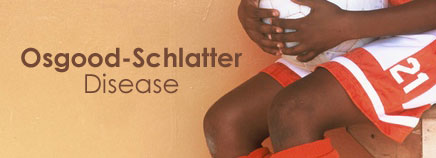
Good news: Osgood-Schlatter disease (OSD) is far less frightful than its name. Though it’s one of the most common causes of knee pain in adolescents, it’s really not a disease, but an overuse injury. OSD can be quite painful, but usually resolves itself within 12 to 24 months.
About Osgood-Schlatter Disease
Osgood-Schlatter disease is an inflammation of the bone, cartilage, and/or tendon at the top of the shinbone (tibia), where the tendon from the kneecap (patella) attaches. Most often only one knee is affected.
OSD usually strikes active adolescents around the beginning of their growth spurts, the approximately 2-year period during which they grow most rapidly. Growth spurts can begin any time between the ages of 8 and 13 for girls, or 10 and 15 for boys. OSD has been more common in boys, but as more girls participate in sports, this is changing.
Teens increase their risk for OSD if they play sports involving running, twisting, and jumping, such as basketball, football, volleyball, soccer, tennis, figure skating, and gymnastics. Doctors disagree about the mechanics that cause the injury but agree that overuse and physical stress are involved.
Growth spurts make kids vulnerable because their bones, muscles, and tendons are growing quickly and not always at the same time. With exercise, differences in size and strength between the muscle groups place unusual stress on the growth plate at the top of the shinbone. (A growth plate is a layer of cartilage near the end of a bone where most of the bone’s growth occurs. It is weaker and more vulnerable to injury than the rest of the bone.)
Most parents call the doctor after their child complains of intermittent pain over several months. The pain may be anywhere from mild and felt only during activity to severe and constant.
Other symptoms may include:
- pain that worsens with exercise
- relief from pain with rest
- swelling or tenderness under the knee and over the shinbone
- limping after exercise
- tightness of the muscles surrounding the knee (the hamstring and quadriceps muscles)
Symptoms that aren’t typical of OSD include pain at rest, thigh pain, or very severe pain that awakens kids from sleep or makes them cry. If your child has any of these symptoms, talk to your doctor.
How Is It Treated?
OSD usually goes away when a teenager’s bones stop growing, usually between 14 and 18 years. Until then, only the symptoms need treatment. Rest is the key to pain relief. Parents find it a cruel irony that the most active kids are most likely to get OSD — and also the ones least likely to rest the affected area.
In mild cases, doctors advise that kids limit the activities that cause pain. They might be able to continue their sports as long as the pain remains mild. When symptoms flare up, a short break from sports might be necessary.
After your child gets back in the game, shock-absorbent insoles can decrease stress on the knee. Applying moist heat for 15 minutes before or icing for 20 minutes after activity can minimize swelling. Wrestling gel pads and basketball knee pads (available at sporting goods stores) can protect a tender shin from bumps and bruises. A good stretching program, focusing primarily on the hamstring and quadriceps muscles, before and after activity is important. Your doctor might also suggest over-the-counter pain medicines, such as ibuprofen, or prescription anti-inflammatory medicines.
More severe cases require more rest, usually a total break from sports and physical activities. Active kids may find this very difficult, but the knee cannot heal without rest. Some teens wind up with a cast or brace to enforce the doctor’s orders. After a prolonged time off, kids will need to ease back into activity carefully, usually with physical therapy to learn stretching and strengthening exercises.
Long-term consequences of OSD are usually minor. Some kids may have a permanent, painless bump below the knee. In rare cases, they may develop a painful, bony growth below the kneecap that must be surgically removed. About 60% of adults who had OSD as kids experience some pain with kneeling.

